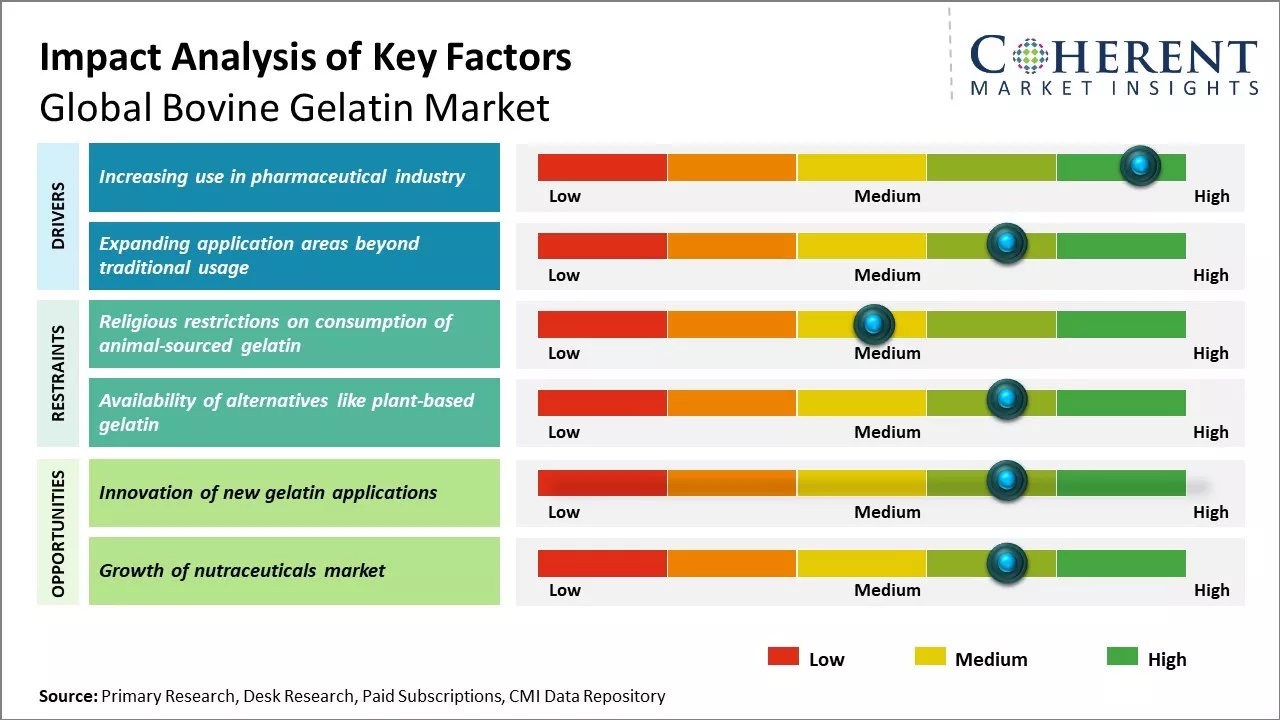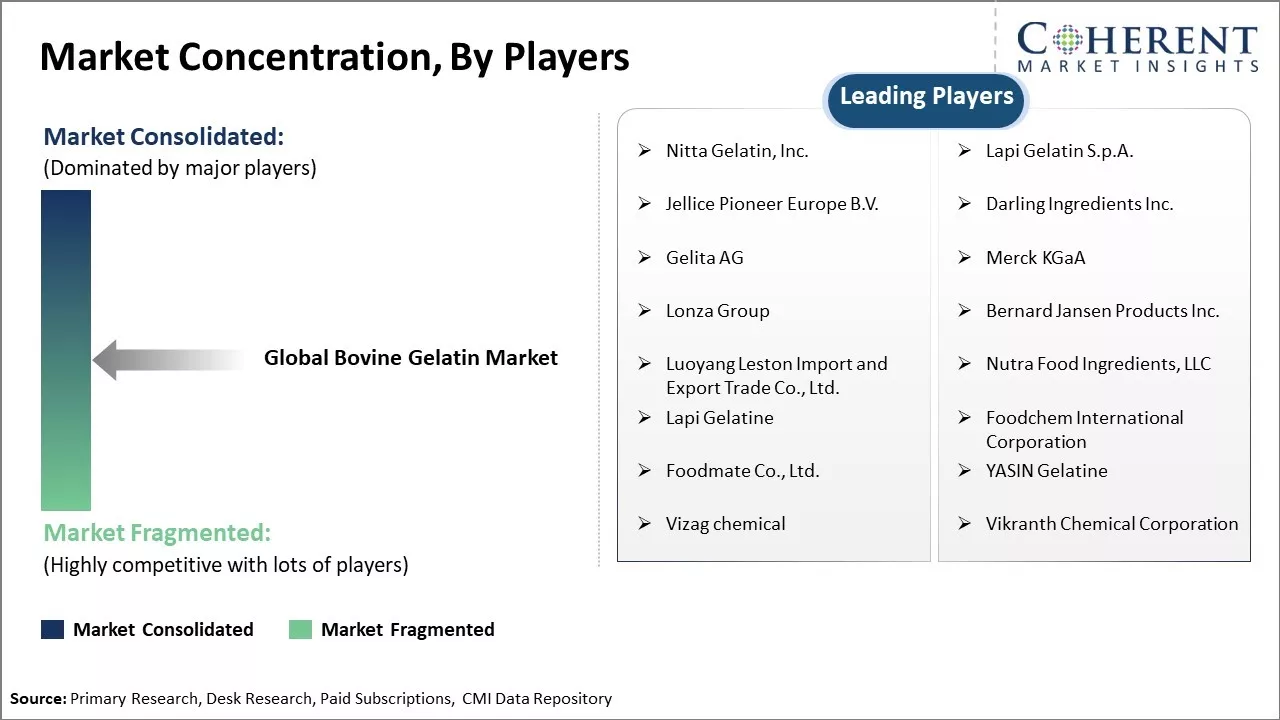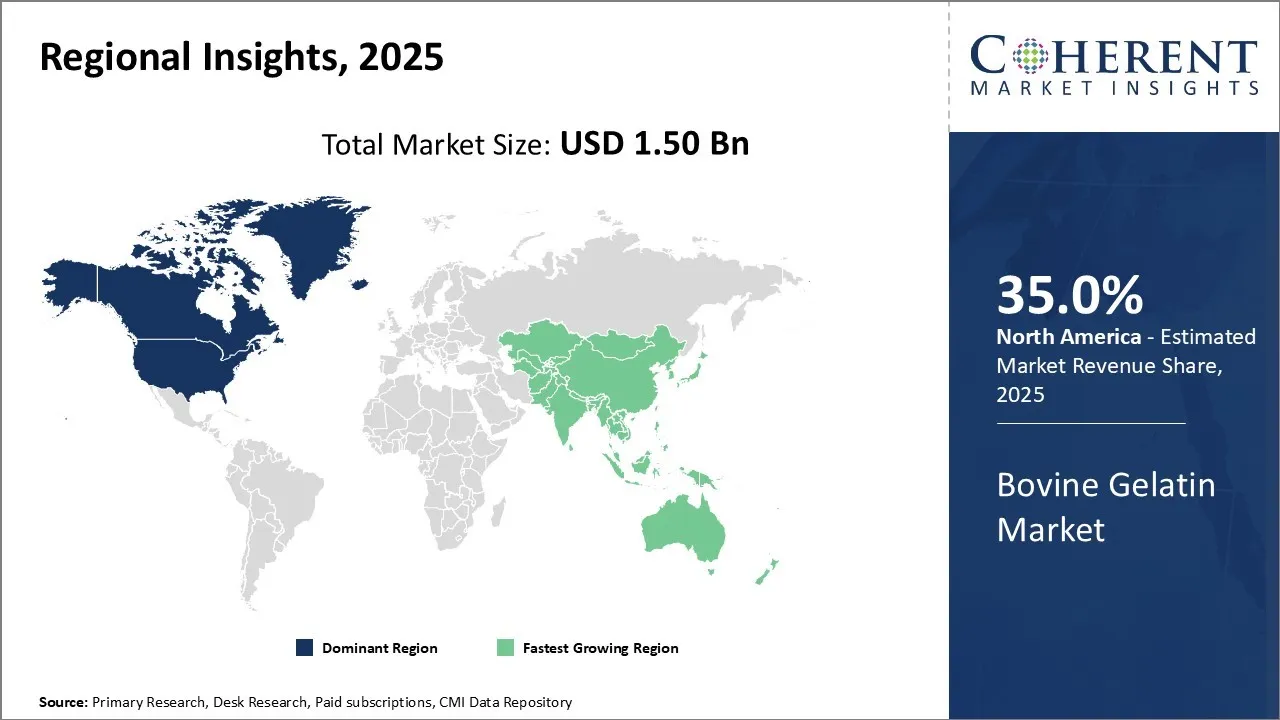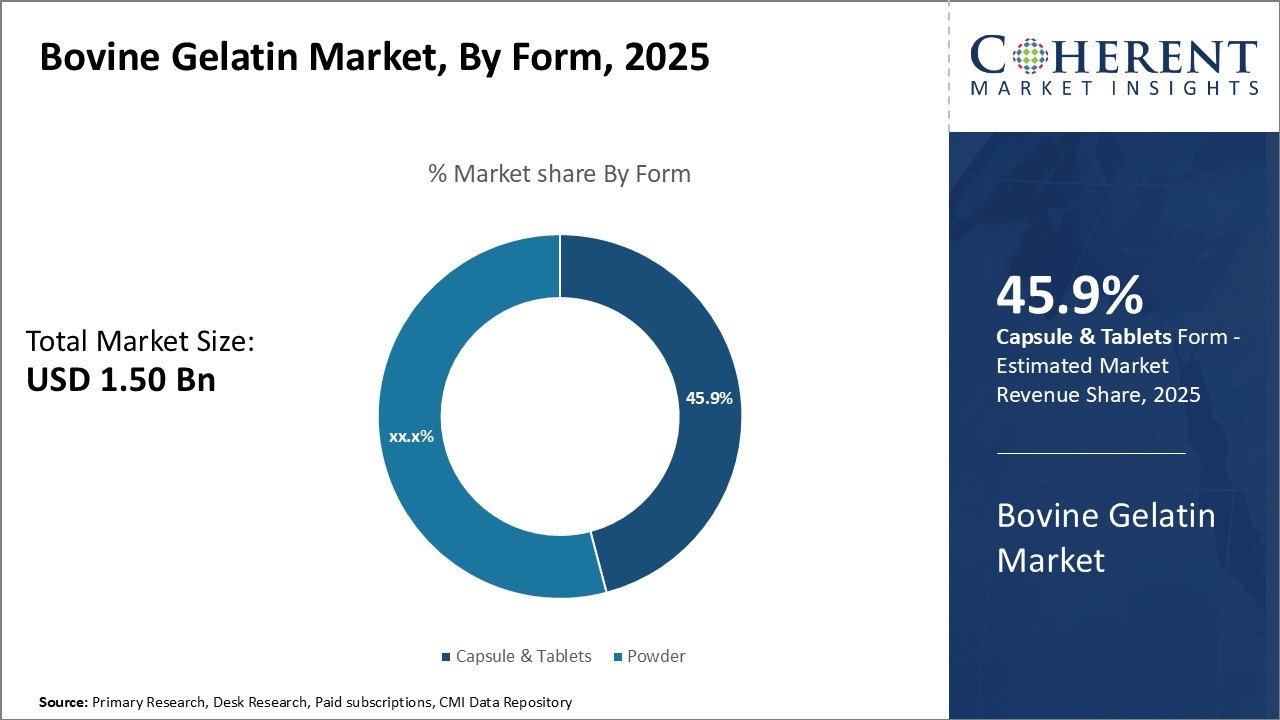Bovine Gelatin Market Analysis & Forecast: 2025-2032
The Bovine Gelatin Market size is estimated to be valued at
USD 1.50 Bn
in 2025 and is expected to reachUSD 2.43 Bn
by 2032, exhibiting a compound annual growth rate(CAGR) of 7.1%
from 2025 to 2032.
To learn more about this report, Download Free Sample
Key Takeaways
- By Form, the projected Capsule & Tablet consumption for 2025 indicates it will possess a bovine gelatin market share of 45.9%. The rising popularity of supplements in gelatin capsule format as well as the consumer preference towards easier to consume forms of gelatin is likely to help maintain this position.
- By Application, the Food & Beverages segment is expected to hold the largest market share of 41.7% in 2025 due to confectionery, dairy, and meat products increasingly using gelatin for gelling, stabilizing and thickening purposes.
- By Region, North America is anticipated to command the largest shares at 35.0% in 2025, supported by a robust food processing sector as well as increasing consumption of health supplements and the preference towards bovine gelatin over porcine sources.
Market Overview
The bovine gelatin market growth is expected to witness significant growth over the forecast period. This is due to growing demand from the food & beverage industry as a gelling agent, stabilizer, and thickening agent is expected to boost the market growth. Gelatins significant advantages over other hydrocolloids, such as faster melting properties, ease of use at different temperatures, transparency, and better strength, make it popular for use in confectionaries, desserts, baked goods, and meat products.
Bovine gelatin is also finding increasing usage in personal care products due to its excellent moisture retention and skin-healing properties. Further, rising demand for functional foods and beverages owing to changing consumer lifestyles and increased health awareness is likely to propel the bovine gelatin market growth.
Current Events and Its Impact
|
Event |
Description and Impact |
|
Major Disease Outbreaks in Cattle Populations |
|
|
Technological Market Disruptions |
|
|
Supply Chain & Raw Material Crises |
|
Uncover macros and micros vetted on 75+ parameters: Get instant access to report
Emerging Applications
The bovine gelatin market forecast is set for significant transformation by tapping into underexplored niche sectors beyond its traditional strongholds in food, pharmaceuticals, and cosmetics. These emerging and future applications present lucrative opportunities for market participants to diversify and grow.
- 3D Bioprinting: Due to biocompatibility and mechanical strength, gelatin is increasingly being used as a bioink for 3D printing tissue and organ models. Other industry leaders such as Gelita AG are also adopting it in cell culture regenerative medicine and in vitro testing platforms where gelatin facilitates cell viability and differentiation.
- Pet Food Supplements: There is an increasing demand for premium grade pet nutrition products with formulated bovine gelatin incorporated into functional treats targeting joint health and coat condition. Industry leaders like Mars Petcare and Purina are using hydrolyzed gelatin to meet rising veterinary pet care needs resulting from pet anthropomorphism.
- Lab Cultured Meat Scaffolds: Research projects like those by Mosa Meat are looking into using gelatin as an edible supporting structure to enhance cell distribution and growth for cultivated meat. This supports the rapidly growing cultured meat market, expected to be valued at $25 billion by 2030.
- Biodegradable packaging: The ability of gelatin to form films is being employed to create eco-friendly, biodegradable food wraps and capsules. Startups like Traceless Materials want to target the projected $10 billion market for sustainable packaging by 2035 and focus on replacing single-use plastics.
These emerging applications not only offer premium pricing potential but also enable gelatin producers to secure long-term strategic partnerships in high-growth industries. Early investment in R&D and scalability will be critical to capitalize on these expanding segments ahead of market saturation.
Pricing Analysis
The global bovine gelatin market demand, valued at $2.66 billion in 2024 and growing at a 7.1% CAGR, shows varied pricing influenced by product grade, application, region, and distribution channels. Europe leads with 35-40% market share, followed by Asia-Pacific at 28-32%.
Product Grades & Form Factors
- Pharmaceutical Grade: $8–12/kg
- Food Grade: $5–9/kg
- Cosmetic Grade: $6–10/kg
- Powder (60-65% market share): $5.5–10/kg
- Sheets: $7–12/kg
- Capsules: $0.02–0.05/unit
Application Pricing
- Food & Beverage: $5.5–8.75/kg (e.g., confectionery, dairy)
- Pharmaceuticals: $9.5–24/kg (hard capsules to plasma expanders)
- Cosmetics/Photographic: $7.8–13.5/kg
Regional Pricing Highlights
- Europe: Higher pricing, especially pharma grade ($10.5–14.75/kg)
- Asia-Pacific: Generally lower prices ($5.5–11.25/kg depending on grade)
Competitive & Channel Pricing
- Tiered pricing by leaders like Gelita AG and Darling Ingredients
- B2B discounts: 15–25% depending on contract volume
- B2C markups: 40–60%, plus e-commerce surcharges for small orders
- Overall, production is adapting to meet diversified market needs with an emphasis on quality, sustainability, and scalability.
Increasing use in pharmaceutical industry
The use of bovine gelatin has been rising steadily in the pharmaceutical industry over the past decade. Gelatin is used widely in the manufacture of hard and soft gel capsules to deliver pharmaceutical products in soluble and dispersed states. It serves as an excellent matrix material for controlled drug release applications.
Gelatin capsules are preferred over other delivery methods due to their ease of ingestion and accurate dosing abilities. The rising global healthcare expenditure and growing elderly population have fueled the demand for drugs and supplements. This has provided a push to the overall pharmaceutical market. With newer and more complex drug molecules entering the pipeline, the need for effective drug delivery carriers is greater than ever.
Market Concentration and Competitive Landscape

To learn more about this report, Download Free Sample
- The bovine gelatin market analysis primarily depends on the collagen which is obtained from the hides and bones of cattle using hydrolysis. It has been noted that main production centers are located where there is large scale cattle ranching; these include North America, Europe as well as Asia Pacific.
- Some key steps to be followed include procurement of raw materials, pretreatment, hydrolysis, filtration, drying as well as packing. Sourcing raw hides of good quality is crucial as it affects the yield and grade of gelatin produced which makes it a matter of utmost importance. So-called ‘sustainability’ and ‘traceability’ have come to the front because of increasing legal and regulatory frameworks and market pressure from consumers.
- New technologies have been developed to enhance the efficiency of production and purity of the end product, such as the use of enzymatic hydrolysis and membrane filtration. Leading manufacturers are resorting to the use of robotics and optimization of processes to cut back on the energy required and waste produced.
- Emerging economies from the food and pharmaceutical businesses, as well as bioprinting and pet nutrition, are expected to increase overall production capacity alongside the rising demand. That said, rampant changes in the supply of raw material, especially bovine hides, negatively impacts output costs and supply stability.
- Asia Pacific is set to experience an increase in capacity due to rising exports and growing domestic consumption. These shifts are coupled with a focus from European producers towards high-grade pharmaceutical gelatin production adhering to stringent GMP standards.
Expanding application areas beyond traditional usage
While gelatin has long been used as a gelling agent and stabilizer in food products, its application scope has broadened in recent years. Traditionally, gelatin found widespread use in confectionery, dairy, and bakery goods due to properties like viscosity adjustment and textural appeal. However, sectors like cosmetics and personal care have emerged as new avenues of growth. Many skincare and hair care products today contain gelatin, either as a structuring agent or active ingredient.
Gelatin derivatives are being trialed as bio-inks and hydrogels in niche applications of organ printing and tissue engineering. Even sectors like pharmaceutical capsules and nutraceuticals, though not new adopters, are propelling ongoing gelatin needs due to constant portfolio expansion and new product launches. The versatility of gelatin to impart unique handling properties across diverse formulations, without detrimental health effects, will continue bolstering its cross-industry demand going forward.
Market Opportunities
- Innovation of new gelatin applications
The bovine gelatin market has experienced steady growth over the past decade primarily driven by its widespread applications in food, pharmaceuticals and nutritional supplements. However, with advancements in material science and biotechnology, innovative new applications for gelatin are emerging which can be a massive growth opportunity for this market. One such area is in 3D bioprinting where gelatin is being increasingly used as a bioink.
Gelatin provides an ideal substrate for cell growth and differentiation making it well-suited for bioprinting tissues and organ models. Several studies have shown that gelatin based bioinks support cell viability, proliferation and morphology. This application of gelatin for bioprinting could revolutionize the fields of regenerative medicine, drug discovery and personalized healthcare solutions in the coming years.
Bovine Gelatin Market Insights, by Form
The capsule & tablets segment is expected to hold 45.9% share in the bovine gelatin market value by form in 2025. Gelatin capsules and tablets offer numerous advantages over other forms that drive their popularity. Compared to powdered gelatin, capsules and tablets are much more convenient for direct consumption. They eliminate the need for mixing the gelatin with liquid before ingesting. This ease of use without any preparation makes capsules and tablets highly preferable for pharmaceutical and supplement applications.
Gelatin capsules and tablets also allow for accurate dosing of active ingredients. Manufacturers can carefully control the amount of medication or supplement in each dose. This consistency in dosing is important for ensuring therapeutic efficacy and consumer safety. The solid and compact nature of capsules and tablets also makes them more portable and easier to carry compared to loose powders. Patients prefer the hassle-free consumption on-the-go without any mixing required.
Bovine Gelatin Market Insights, by Application
The food and beverages segment are expected to hold 41.7% share in the bovine gelatin market trend in 2025, due to gelatin's extensive usage across various food products. Gelatin is commonly used as a gelling agent and stabilizer to improve texture and stability. It helps thicken sauces, yogurt, and puddings while also suspending particulate matter. Gelatin is also widely used in confectionery products such as gummy candies, marshmallows, and jellies due to its ability to form stable gels at low concentrations.
In processed meats, gelatin is valuable as a binding agent and emulsifier. It helps distribute fat evenly throughout meat products for a juicier, smoother texture. Gelatin coatings on processed meats also aid moisture retention during cooking to prevent shriveling and drying out. The cosmetics and photographic industries also utilize gelatin for its gelling properties. In pharmaceuticals, gelatin is valued as an excipient for making hard and soft capsules as well as improving tablet properties.
Regional Insights

To learn more about this report, Download Free Sample
North America Bovine Gelatin Market Analysis and Trends
North America is projected to lead the global bovine gelatin market, accounting for an estimated 35% market share in 2025. This dominance is attributed to the strong presence of established gelatin manufacturers in the U.S. and Canada, coupled with well-integrated manufacturing and distribution networks across domestic and international markets.
The region benefits from robust cattle farming industry, ensuring steady and cost-effective access to bovine bones, a key raw material. Additionally, growing health consciousness among consumers is driving increased demand for gelatin-based applications in pharmaceuticals, cosmetics, photography, and food & beverages. Regulatory rigor has further elevated product quality and safety, reinforcing consumer trust and sustaining long-term market growth.
Asia Pacific Bovine Gelatin Market Analysis and Trends
Asia Pacific is expected to be the fastest-growing region in the global bovine gelatin market over the forecast period. Rapid urbanization, rising disposable incomes, and increasing health awareness are key growth drivers across major economies such as India, China, and Indonesia.
The expanding use of gelatin in nutraceuticals, dietary supplements, confectionery, and photographic applications is fueling regional demand. Furthermore, cost advantages and easy raw material availability have positioned the region as a strategic manufacturing hub for global players. While dependence on imports for certain specialized gelatin types remains a challenge due to limited domestic processing infrastructure, ongoing investments by multinational companies are expected to enhance local production capabilities and boost exports.
Dominating Countries in the Bovine Gelatin Market
United States Bovine Gelatin Market Analysis and Trends
The U.S. continues to dominate the North American bovine gelatin market, supported by its vast cattle farming industry and the presence of several key gelatin manufacturers. The country’s advanced regulatory framework ensures high-quality gelatin production, meeting stringent safety standards demanded by pharmaceutical, food, and cosmetic industries. Rising consumer preference for natural and clean-label ingredients is further increasing demand for bovine gelatin-based products. Continued investments in manufacturing innovation and supply chain optimization are expected to sustain the U.S. market leadership.
India Bovine Gelatin Market Analysis and Trends
India is emerging as a high-growth market within the Asia Pacific region, driven by rapid urbanization, rising health consciousness, and expanding applications of gelatin in dietary supplements and confectionery. According to Invest India, India produced 28.43 million vehicles in the fiscal year 2023-2025, marking it as the third-largest automobile market globally — indirectly supporting demand for gelatin in automotive-related applications such as photographic films and coatings. Government incentives aimed at boosting local manufacturing and increasing export potential are expected to accelerate market growth in the coming years.
Market Report Scope
Bovine Gelatin Market Report Coverage
| Report Coverage | Details | ||
|---|---|---|---|
| Base Year: | 2024 | Market Size in 2025: | USD 1.50 Bn |
| Historical Data for: | 2020 To 2024 | Forecast Period: | 2025 To 2032 |
| Forecast Period 2025 to 2032 CAGR: | 7.1% | 2032 Value Projection: | USD 2.43 Bn |
| Geographies covered: |
|
||
| Segments covered: |
|
||
| Companies covered: |
Nitta Gelatin, Inc., Lapi Gelatin S.p.A. , Jellice Pioneer Europe B.V., Darling Ingredients Inc. , Gelita AG , Merck KGaA , Lonza Group , Bernard Jansen Products Inc. , Luoyang Leston Import and Export Trade Co., Ltd. , Nutra Food Ingredients, LLC, Lapi Gelatine, Foodchem International Corporation, Foodmate Co., Ltd., YASIN Gelatine, Vizag chemical, Vikranth Chemical Corporation |
||
| Growth Drivers: |
|
||
| Restraints & Challenges: |
|
||
Uncover macros and micros vetted on 75+ parameters: Get instant access to report
Analyst Viewpoint
- The bovine gelatin market is expected to experience steady growth in the coming years. The food industry will continue to be a key driver of demand as gelatin is widely used to improve texture and moisture retention in confectionery, desserts, and dairy products.
- Growing health consciousness may also boost the consumption of gelatin supplements and pharmaceutical products due to its digestive and joint health benefits. Meanwhile, the pharmaceutical industry is likely to see increased gelatin usage for capsule shells, wound dressings, and medical devices.
- Religious and cultural dietary restrictions could pose a challenge for the market. Some Asian and Middle Eastern countries have significant vegetarian and vegan populations that avoid animal products.
- The market sees opportunities from product innovation and functional ingredients. Gelatin producers are developing new formulations targeted at sports nutrition, beauty supplements, and other niche wellness segments.
- Encapsulation technologies allowing for controlled release and taste masking also have promise. Geographically, Asia Pacific holds strong prospects with high meat consumption and a burgeoning middle class in populous nations like India and China.
Bovine Gelatin Market Key Developments
- In February 2025, Traceless Materials secured $20 million in Series B funding to advance development of gelatin-based biodegradable packaging solutions, targeting sustainability-driven market growth.
- In January 2025, Gelita AG inaugurated a state-of-the-art bovine gelatin production facility in Germany, boosting its annual capacity by 12,000 tons to support growing pharmaceutical and food sector demands.
- In July 2024, Nitta Gelatin introduced a new range of cold-water soluble bovine gelatin products aimed at premium dietary supplements and functional foods, addressing increasing consumer demand for convenience.
- In March 2024, Darling Ingredients formed a strategic alliance with an Asian collagen manufacturer to strengthen its supply chain and capitalize on the expanding Asia-Pacific bovine gelatin market.
Market Segmentation
- Form Insights (Revenue, USD Bn, 2020 - 2032)
- Powder
- Capsule & Tablets
- Others
- Application Insights (Revenue, USD Bn, 2020 - 2032)
- Food and beverages
- Cosmetics & personal care
- Pharmaceuticals
- Others
- Regional Insights (Revenue, USD Bn, 2020 - 2032)
- North America
- U.S.
- Canada
- Latin America
- Brazil
- Argentina
- Mexico
- Rest of Latin America
- Europe
- Germany
- U.K.
- Spain
- France
- Italy
- Russia
- Rest of Europe
- Asia Pacific
- China
- India
- Japan
- Australia
- South Korea
- ASEAN
- Rest of Asia Pacific
- Middle East & Africa
- GCC Countries
- Israel
- Rest of Middle East & Africa
- Key Players Insights
- Nitta Gelatin, Inc.
- Lapi Gelatin S.p.A.
- Jellice Pioneer Europe B.V.
- Darling Ingredients Inc.
- Gelita AG
- Merck KGaA
- Lonza Group
- Bernard Jansen Products Inc.
- Luoyang Leston Import and Export Trade Co., Ltd.
- Nutra Food Ingredients, LLC
- Lapi Gelatine
- Foodchem International Corporation
- Foodmate Co., Ltd.
- YASIN Gelatine
- Vizag chemical
- Vikranth Chemical Corporation
Sources
Primary Research interviews
- Industry Experts (Food & Pharmaceutical Sectors)
- Senior Executives from Leading Gelatin Manufacturers
- Raw Material Suppliers (Cattle By-Product Providers)
- Nutritionists and Nutraceutical Formulators
- Others
Databases
- Others
Magazines
- Food Technology Magazine
- Pharmaceutical Processing World
- Nutraceuticals International
- Others
Journals
- Journal of Food Science and Technology
- International Journal of Biological Macromolecules
- Trends in Food Science & Technology
- Others
Newspapers
- Food Navigator
- NutraIngredients
- Global Meat News
- Others
Associations
- Gelatin Manufacturers Institute of America (GMIA)
- International Food Additives Council (IFAC)
- European Federation of Pharmaceutical Industries and Associations (EFPIA)
- Others
Public Domain sources
- USDA Agricultural Marketing Service
- FDA Food Safety Modernization Act (FSMA) Reports
- European Food Safety Authority (EFSA) Publications
- Others
Proprietary Elements
- CMI Data Analytics Tool
- Proprietary CMI Existing Repository of Information (Last 8 Years)
*Definition: The bovine gelatin market involves the manufacturing and sale of gelatin derived from cows. Bovine gelatin is commonly used as a gelling agent, binder, and thickening additive in various food products like candies, yogurt, and marshmallows. It is also utilized in pharmaceutical capsules, medication coatings, photographic films, and cosmetic products. The key players in this market manufacture and supply high-quality bovine gelatin on a commercial scale to meet the demands of food, pharmaceutical, photographic, and cosmetics industries worldwide.
Share
Share
About Author
Sakshi Suryawanshi is a Research Consultant with 6 years of extensive experience in market research and consulting. She is proficient in market estimation, competitive analysis, and patent analysis. Sakshi excels in identifying market trends and evaluating competitive landscapes to provide actionable insights that drive strategic decision-making. Her expertise helps businesses navigate complex market dynamics and achieve their objectives effectively.
Missing comfort of reading report in your local language? Find your preferred language :
Transform your Strategy with Exclusive Trending Reports :
Frequently Asked Questions
EXISTING CLIENTELE
Joining thousands of companies around the world committed to making the Excellent Business Solutions.
View All Our Clients

